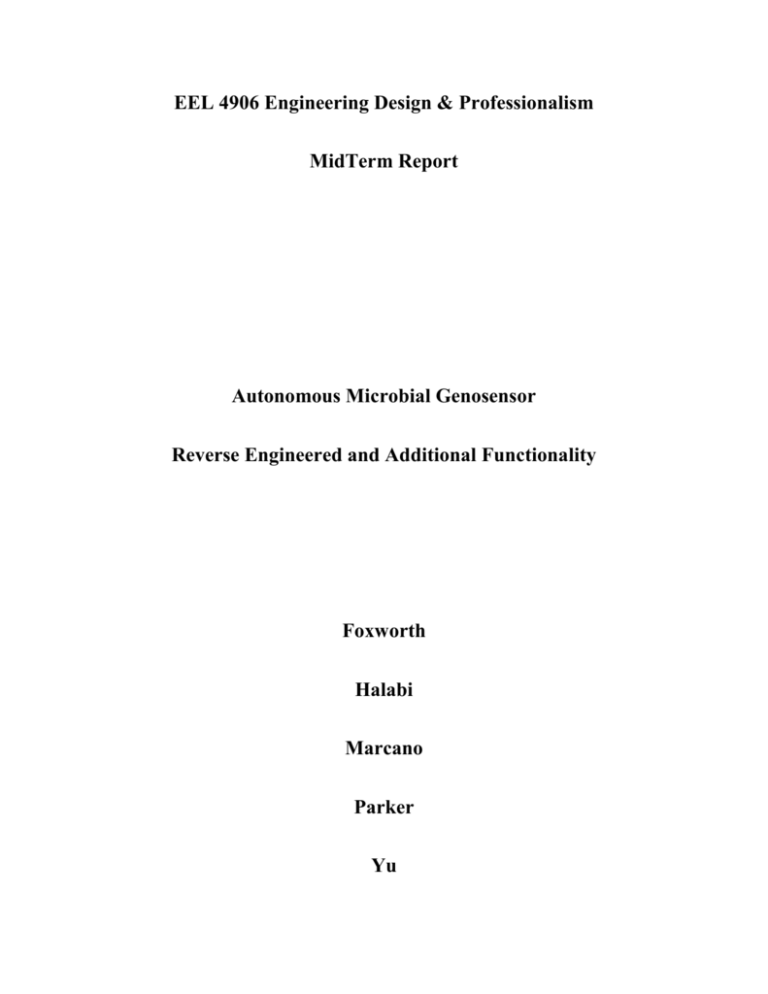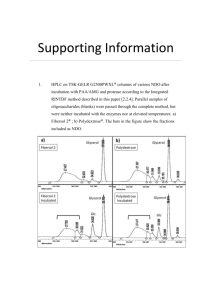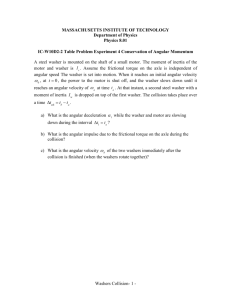File
advertisement

EEL 4906 Engineering Design & Professionalism MidTerm Report Autonomous Microbial Genosensor Reverse Engineered and Additional Functionality Foxworth Halabi Marcano Parker Yu 1. Robotic Sampling System Teardown and Analysis The Autonomous Microbial Genosensor, commonly referred to the AMG for short, is a fully automated system that is used for genetic analysis within bodies of water: but more precisely, for use within various oceans. Once the AMG has been relocated to it desired research location (underwater), it can use its various systematic functions to perform RNA extraction/purification/concentration, filtration, gene amplification, data transmission, and even cell lysis. Weighing only 34 Kilograms, and having a housing enclosure of a 20.3 cm diameter by a 122 cm height, the AMG is small enough that it can be transported easily, yet large enough so that a sea creature cannot eat it. The housing enclosure is made out of hardened aluminum in order to be rust resistance, as well as to create an enclosure that is significantly lighter than say if it had been made out of hardened steel. With a depth capability of 60 meters, the AMG is able to be positioned deep into the, perhaps murky, abyss, known formally as the ocean. As for the AMG's ability to communicate, it uses RS-232 for serial communication. For those unfamiliar with the RS-232, do not be alarmed. It is the common “Serial” port that was found on personal computers, before the rise of the great Universal Serial Bus, non-formally known as the USB, came into an era of great fruition. The AMG can also optionally communicate through 802.11x. 802.11x was developed by IEEE for wireless communication through local area network (LAN) technology. Behind all of the mechanics and electronics of the AMG, lies the operating system for the main computing device: Windows. As for power, it can use 4 military grade Lithium ion batteries, or it can run off of an AC/DC adapter. The Lithium ion batteries are rated at 6.0 AmpHours at 30 Volts, or at 12.0 Amp-Hours at 15 Volts. The AC/DC adapter can receive an input of 100-260 Volts AC, or 24 Volts DC, and converts it to 16.8 Volts DC rated at 5 Amperes. 1.1 Collecting Samples Used for Testing Water samples are collected into the device via a syringe pump. The syringe pump is very useful for microfluidic applications. It can perform both infusion and withdrawal and liquid volume can be programmed based on the speed of the pump, input pulse width frequency, and valve timing. The sampling capability of the AMG is between 30-50 milliliters of water. Once the sample(s) are collected, they are processed one after another through two different rotating wheels. Filtration, cell lysis, and RNA purification, is accomplished through the first wheel. RNA amplification is then administered during the second rotating wheel, via Real-Time Nucleic Acid Sequence Based Amplification: or RT-NASBA for short. 1.2 Analysis of AMG Sample Collection When the collected samples are then run through the collection/filtration columns (the first rotating wheel), standard micropipette tips are utilized as a viable fluidic collection medium. Manipulation and transport of the fluids through the system is achieved by way of micro-valves, pumps, and custom manifolds. After the cells have been transported to a filter, chemical cell lysis, and RNA purification is administered via using buffers. After the RNA purification processes has been completed, the RNA is then released by using a customized NASBA reagent buffer. The reagents that were used during the sampling process are then collected and stored within the AMG, in a specifically designated waste storage bag that would later be properly disposed of after the AMG had been retrieved. 1.3. Analytical Amplification of RNA As previously discussed, the purpose of the AMG is to analyze the cells and/or various targeted organisms. To identify targeted organisms, the AMG uses Real-Time Nucleic Acid Sequence Based Amplification (RT-NASBA), as previously mentioned. The NASBA process is accomplished by utilizing a custom built single reagent sphere. A reaction is then started by using lyophilized NASBA spheres that contain molecular beacons, primers, and various NASBA enzymes. 1.4. Transmission of Data The AMG utilizes a 2.4GHz ISM band wireless connection to transmit the data to an on- shore location: the range is approximately 1000 feet. Interestingly enough, although the wireless unit can be placed inside of the AMG's enclose, it can also be attached externally within a flotation buoy. With the external communication option, a power supply is integrated into the buoy as well; the benefit of this is that it enables the AMG to have a non-interrupted data transfer, as well as creating a second communication channel available if a secondary CTD sensor is installed into the buoy. 2. Problem Formulation Many people personally upkeep their own jet skis and small boats. One part of this process is to rinse off the exterior boat or jet skis with fresh water or prevent future damage and to make the equipment last longer. Sometimes after a long use of the equipment, the exterior can develop difficult areas to rinse/wash off. The solution to this problem is to use pressure washer to clean these areas better. The problem that arises is that you can only use the pressure washer while the boat is docked and there is a source of fresh water. However, if the user wanted to use the pressure washer while boating, he/she is out of luck. While out on the water, the boat deck can experience uncleanliness; this could be anywhere from dirt to spilled beverages or fish guts. Our solution to this problem is to implement a water source pump to the AMG. Now the user will have the convenience to pressure wash their boat while out in the water or if there is no source of water at their boat dock. Another part of the upkeep process after using a jet ski or boat is to flush out the motor and rinse off parts of the equipment with fresh water. This is done to prevent the motor from developing growths and blockage in the motor itself, which means that at high speeds the motor could easily overheat. In the same way, the AMG should to be rinsed off or pressure washed with fresh water and the motor for the pressure washer needs to be flushed out with fresh water as well. In the future, we expect that this system will be largely implemented in the US and in other countries, which makes us think of maintenance and reusability of the system. Our biggest concern is maintenance, which will require one or more technicians to fix any issues that the system may have either underwater or in the surface. For the latter case, the technician will be required to bring the AMG to the surface, which poses no difficulties or safety issues. For the former case, however, the technician will be required to dive in the water to fix the system. Unfortunately, the system does not provide support to guaranty the integrity of the technician’s life. Thus, the scope of this function is to measure the technician’s heart rate and send it to the control station, while he is providing maintenance to the AMG underwater. 3. System Function 3.1. Systematical Functionality of Advanced Pressurized Washer Every day, particles of dirt, mold, algae, bird fecal matter, cat fecal matter, and even barnacles, can be found on varying given surfaces. But how can these obstacles be eradicated when the desire is met by a human? Let me take you back to the dawn of cleanliness: To the dawn of soap. The year is 2800 B.C., the Babylon's have just developed a formula for soap consisting of water, alkali, and Cassia oil. Back to 2014, what if I told you that soap was not necessarily needed, or even viable, to clean the aforementioned substances off of various surfaces? You would be intrigued, as most people who are interested in the fine art of cleanliness. I present to you, the all new advanced pressurized washer implementation that is only available on the 2014 AMG model. For those times when you had just finished a long day at sea, and you decided to retrieve your AMG for data sampling/maintenance reasons, you can now also pressure wash was your boat while at sea. Whether that encompasses just washing the deck of fish guts, or the sides of your boat to get rid of barnacle accumulation, the new pressure washer function of the 2014 AMG model will meet the needs of your bi-monthly sea life. 3.2. Function of Heart Monitoring System To measure the technician’s heart rate, we will develop an electrocardiogram (ECG) sensor, which will be adapted to work underwater and will be as inexpensive as possible. Existing commercial ECG sensors consist of external packaging, internal circuitry, a display, and electrodes to obtain the electrical signals of the heart. The packaging of these sensors can protect the internal circuitry from water, and the electrodes support exposure to water. Nevertheless, very few ECG sensors can be submerged many yards, which is necessary for the system at hand. Since the explosion of wearable technologies, we have seen successful, commercial biometrics devices adapted in many ways to please the consumer. Our plan is to use the same materials to guarantee the success of our ECG sensor. The devices that caught our attention are the New Balance LifeTRNR, also known as New Balance Life Trainer. These are a set of the commonly called “smart watches”, which measure heart rate, acceleration, among other metrics. The part that interests us the most is the fact that watches are waterproof and water resistant. Thus, we are going to use the same materials to implement the electrodes and make the system flexible, to allow the technician to move freely underwater. The electrodes will obtain the signals from the heart, which will then be filtered and amplified by a circuit and sent to a control module using the system’s microcontroller. The microcontroller will receive analog signals, convert them into digital and save them in an onboarding memory to send it later to the control station. This process will use the same algorithms used by the microcontroller to send the other signals to the control station. 4. Extra Sensor Definition 4.1. Pressure Washer Compatibility Definition For the pressure washer addition, we only added a small section to the AMG. As seen in Figure 4.1, the actual pressure washer is system is external from the AMG. The addition we added to the AMG is only the water source for the pressure washer. The user has to provide the pressure washer. The first part of our addition to the AMG is the filter for the water. For this filter, the small water pump will intake a steady amount of water through the filter to clean out any debris before entering into the water hose. Next, the small water pump will pump the filtered water through the hose and into the water tank. From the tank, the water pump, located on the boat deck, will pull the water from the AMG’s water tank through a more refined filter and up to pressure washer. Now from this point the user has already chosen whether to use the soap mixture or not. Assuming the user did choose to use the mixture, then the water pump will intake the soap mixture and the water from the tank and push the water at high pressure into the highpressure hose. Finally, once the water has reached the high-pressure hose, it is now at the hand of the operator to use with whichever cleaning attachment he has chosen. 4.2. Heart Rate Monitor Definition Typical ECG signals are between 0.1 to 5 mV. A typical method to measure one’s ECG is to use an instrumentation amplifier with inputs coming from contacts connected to two parts of one’s body. An instrumentation amplifier is a differential amplifier that has inputs of two buffer amplifiers, which eliminates the need of input impedance matching. Figure 4.2.1. Typical Instrumentation Amplifier Circuit (Using Op-Amps) The gain of the circuit in Figure 1 is basic differential amplifier with gain of Vout 2R1 R3 = (1+ ) . The rightmost op-amp is a V2 - V1 Rgain R2 R3 and input resistance 2R2 . Without Rgain , the two R2 leftmost op-amps are simply unity gain buffers. Utilizing Rgain and R1 , we can increase the differential-mode gain of the buffer pair while leaving the common-mode gain equal to 1. The output Vout would then be the amplified ECG signal. After the amplification of the ECG signal, we need to use a low-pass filter to filter out power-line interference (60 Hz) and white noise in order to get good measurements of the ECG signal. Then, the filtered signal will then be sampled through an analog-to-digital converter (ADC), which is then recorded onto the onboard memory of the AMG. Finally, the signal and its data can be recovered using the PC interface where all of the other AMG signals are measured as well. Figure 4.2.2. System Block Diagram Contacts Station Instrumentation Amplifier Onboard Memory Low-Pass Filter Analog-to-Digital Converter In order to implement our system, we will be using the INA114 instrumentation amplifier where only Rgain has to be adjusted to meet our amplification needs. Here the total gain is G = 1+ 50 kW . We can use RG = 250 W for a gain of 200. According to the data sheet provided RG by TI, the INA114 can have a gain anywhere from 1 to 10,000. It operates at a maximum voltage of ±18 V and a maximum current of ±3 mA. Figure 4.2.3. INA114 Schematic For the low-pass filter, we will be using an active circuit to implement for a few reasons: to reduce reliance on input and output impedances of the different components and since we have already an op-amp circuit configuration, we can all use the same power supply. The lowpass filter will be an inverting op-amp amplifier circuit as shown in Figure 4.2.4, having a cutoff frequency at f = 1 = 30 Hz where R2 = 1 kW and C = 5.6 mF . Then, using R1 = R2 = 1 kW 2p R2C yields a pass-band gain of 1. Figure 4.2.4. Active Low-Pass Filter For the ADC, we decided to use the TI ADS1246 because we only need a minimum of 2 kS/s since the highest frequency component would only be about 500-600 Hz. Additionally it provides a fairly high resolution of 24 bit, so that the quantization error can be fairly small, provided that our ECG signal has a peak to peak of about 1-2 V after amplification. According to the data sheet, it operates at ±2.5 V and digital output of 2.7 V. This would mean we need a voltage divider in order to step down the battery power supply voltage. Figure 4.2.5. ADS1246 Analog-to-Digital Converter 5. System Concept Generation 5.1. System Concept Generation When it came to designing our pressure washer system, we had to look at all of the possible uses for the product. Once we settled upon the core theme of cleanliness, we embarked on the endeavor of designing the system layout that would yield maximum efficiency, along with an extended systematic longevity. Our design team considered if we could fit the entire pressure washer, with the exception of the hose and the sprayer, inside of the AMG. However, although there were varying opinions, we decided to put part of the pressure washer inside the AMG, and part of it outside. Inside the AMG we decided to implement a system that could collect water from a body of water, for instance a sea or lake, filter out undesired waste, and then pressurize it enough so that the water can then be fed into an external pressure washer. Upon researching pressure washing, we also settled upon the idea that by adding soap into the pressure washing mix, then the designated surface will be cleaner than if we did not add soap into the mix. The soap dispenser is also housed inside of the AMG's cylindrical enclosure. Since day one, we realized that there are certain risks for the system and for the people operating it and providing technical support for it. Protecting the operator (technician or engineer) was our biggest concern. Since we cannot really control what goes on underwater, we realized that we needed a system to help us help the technician, and the first step is to know if the technician is alive. Given that this task on its own poses certain challenges, we decided to limit the scope of this contribution to the development of an adequate ECG sensor. Given our experience with analog circuits, it was simple for us to design a circuit for an ECG sensor. We chose the components based on the power supply from the AMG and the sampling rate of ECG signals, in the case of the ADC module. Finally, we decided to use water resistant enclosures to protect the electrodes. 6. Requirements Formulation 6.1. Pressure Washer Requirements Formulation The main technical focus of the pre-pressure washer system within the AMG was to be able to supply the external pressure washer with well over 4 gallons per minute of water intake pressure; 4 gallons per minute is the average water consumption of pressure washers. Although that is a very averaged amount, our design team had to start somewhere when it came to noticing what the requirements would be for the device, and then had to design around said requirements. We wanted to create a pre-pressure washer water supplier system that would be able to cater to a wide range of pressure washers, so we decided to use a 12V DC water pump that is able to pump 10 gallons per minute while only using up to 15 Amps. A water pump that is able to pump that much, while only using 15 Amps is something that is commendable in the water pump industry. However, when a device is commendable, whatever said device may be, the cost of the item tends to increase at a rate proportional, sometimes even logarithmically; although it costs $550.00 USD, sometimes it is worth it to spend the extra money in order to get the best quality and design. When it came to choosing the size of the of the water tank that is attached to the outside of the cylindrical AMG enclosure, our design team settled upon 6.3 Gallons. The purpose of the water tank is not meant to serve as a long term water holding facility, so much as just a way to make sure that there is always a continuous flow of filtered water going into the pressure washer. A water tank of 6.3 gallons provided exactly what we needed, without demanding a large amount of space. 7. Market Research This product is aimed for use in a field testing environment, as well as for those interested in a multiuse piece of equipment. The AMG system spends the majority of its time submerged or partially submerged in salt water. The main target consumer is laboratory analysts and scientists. Consumer base also includes those who wish to monitor biological content within a body of water, those who live near a body of water, and boat owners. Our most valuable demographic are those aged 20-65. This includes students, researchers, hobbyists, boaters, fishermen, maintenance workers, technicians, and retirees. Since this relatively compact module contains a large amount of complex electronics, our initial price point is estimated to be around $1250.00. This fee will include a 90-day warranty that covers any manufacturer defects. The warranty does not cover damage caused by user error or misuse. Also included is one year free customer support and a discount on replacement parts and accessories. Almost all of the distribution of the product will be handled through our online store and several authorized distributors. 8. Specifications Item Shurflo 1100-543-510 Water Transfer Pump Filter pads Custom 6.3 gallon container Inlet water hose Outlet water hose Custom soap dispenser Details 10 gallons per minute Need to be changed regularly Made of hardened aluminum 2 inch diameter 1 inch diameter N/A Voltage 12 VDC N/A N/A N/A N/A N/A Cost 550 14.99 274.98 3 4 15 Component Part Cost Instrumentation Amplifier INA114 $4.80 Operational Amplifier LM741 $0.7 Analog-to-Digital Converter TI ADS 1110 $3 5.6E-6 Capacitor 160LLE5R6MEFC6.3X11 $0.33 250 Ohm Resistor PAC100002500FA1000 $0.23 3x 1kOhm Resistors 50m Water resistant plastic enclosure CF14JT1K00 $0.00475 each 9. Design Schematic Contacts Station 10. Instrumentation Amplifier Onboard Memory Simulated Outputs Low-Pass Filter Analog-to-Digital Converter Simulations for Heart Rate Monitor PSpice Circuit Schematic U1 + R4 R6 R9 25k 25k 1k OUT - C1 25k V1 1Vac 0Vdc OPAMP R2 R1 250 5.6u OPAMP - R8 OUT R3 - - OPAMP 1k + U3 25k OPAMP OUT V + U4 R5 R7 25k 25k 0 OUT + U2 0 0 AC Sweep Simulation 250V 200V 150V 100V 50V 1.0Hz V(C1:2) 10Hz Frequency Gain of 200 with cutoff frequency of about 30 Hz 100Hz 11. Packaging Design 12. References "Pressure Washers." How Does a Pressure Washer Work? Accessed 22 March 2014. http://www.explainthatstuff.com/pressurewashers.html http://www.digikey.com/product-detail/en/ADS1110A0IDBVRG4/ADS1110A0IDBVRG4ND/1689058 http://www.marine.usf.edu/systems/?q=amg http://www.soaphistory.net/ http://wiki.answers.com/Q/How_much_water_does_a_pressure_washer_use?#slide=2 http://www.steam-brite.com/shurflo-1100543510-12volt-10gpm-water-transfer-pump-withswitch-with-viton-seals-p-10218.html http://www.alibaba.com/product-detail/-F4-Plastic-waterproof-enclosure_255404683.html http://upload.wikimedia.org/wikipedia/commons/thumb/e/ed/OpAmp_Instrumentation_Amplifier.svg/2000px-OpAmp_Instrumentation_Amplifier.svg.png http://upload.wikimedia.org/wikipedia/commons/thumb/5/59/Active_Lowpass_Filter_RC.svg/20 00px-Active_Lowpass_Filter_RC.svg.png Niccoll, Ryan. Signals and Systems – Lab 5. Retrieved March 22, 2014. http://lyle.smu.edu/~rniccolls/Niccolls_EE2170_Lab5_h.htm Electrocardiogram Measurement Circuit Design Lab. Retrieved March 22, 2014. http://web.mit.edu/2.75/lab/ECG%20Lab.pdf TI INA114 Datasheet. Retrieved March 22, 2014. http://www.ti.com/lit/ds/symlink/ina114.pdf TI ADS1246 Datasheet. Retrieved March 22, 2014. http://www.ti.com/lit/ds/symlink/ads1247.pdf Sedra, Adel S. and Smith, Kenneth C. Oxford University Press, USA. Microelectronic Circuits (Oxford Series in Electrical and Computer Engineering)










